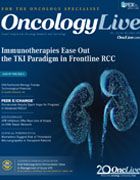Publication
Article
Fee-for-Service Unlikely to Disappear Soon
Author(s):
Fee-for-service tends to result in a surplus of care and unnecessary medical expense, but it probably won’t disappear from the landscape soon.
Allen S. Lichter, MD

Allen S. Lichter, MD
The Centers for Medicare & Medicaid’s (CMS) push to supplant fee-for-service care with value-based care, which is associated with lower cost and better individual treatment, has left oncologists awkwardly trying to make both systems work, according to Allen S. Lichter, MD. This situation is among the key trends likely to shape oncology practice in coming years, said Lichter, a senior partner at the consulting firm TRG Healthcare in Philadelphia, Pennsylvania.
Fee-for-service tends to result in a surplus of care and unnecessary medical expense, but it probably won’t disappear from the landscape soon, Lichter said. Similarly, he does not expect value-based care to become a dominant payment model in the near future. This dualsystem transition spells fits and starts and an overall bumpy road ahead for oncology practices, Lichter told attendees of the Association of Community Cancer Centers’ 45th Annual Meeting & Cancer Center Business Summit, held in Washington, DC.1
“In my opinion, it will be nearly impossible to deliver these different models of care to different populations at the same time,” Lichter said. The growing emphasis on reducing costs of care and improving value for individual patients is turning medicine into more of a business than it has ever been, Lichter said. Therefore, oncologists “must react, embrace, and create ideas and concepts that we as clinicians were not trained for.”
He explained that, in the move toward value-based care, 3 prototype payment models have captured a lot of attention: The Oncology Care Model (OCM) from CMS links payment to financial and performance accountability; the Making Accountable Sustainable Oncology Networks approach by Innovative Oncology Business Solutions is a model designed to stabilize payment flow and care quality during the transition to value-based care; and the Patient-Centered Oncology Payment model is the American Society of Clinical Oncology’s (ASCO) proposed system to provide for higher, more flexible payments than the OCM that ASCO says will support improvements in care quality. “We will have to put our collective mind-sets toward these approaches,” Lichter said.
Other emerging major trends include increased screening and detection and their effect on outcomes, escalating drug costs, real-world data and the growing presence of artificial intelligence (AI), technological improvements to direct and indirect care, and growing awareness of social determinants of health.
Increased sensitivity of tests and growing understanding of the value of surveillance versus active treatment have challenged oncologists to accept the concept of less is more, particularly regarding low-grade prostate cancers, ductal carcinoma in situ, and small papillary thyroid cancer, Lichter noted. In thyroid cancer, the 2 major treatment modalities, thyroid lobectomy and total thyroidectomy, have identical low rates of mortality,2 yet the current standard is predominantly total thyroidectomy, in which patients face hypothyroidism, hypoparathyroidism, and the potential for laryngeal nerve damage post thyroidectomy, Lichter said. Lobectomy carries a lower risk of nerve damage, avoids the risk of hypoparathyroidism altogether, and preserves thyroid tissue. With this approach, many patients may also avoid the need for permanent thyroid hormone-replacement therapy. The greater use of thyroidectomy suggests that a bias for surgery is influencing choice of care and a more careful review of patient options for treatment is merited.
Another significant trend affecting oncology practice is the increase in drug costs. Total oncology drug spending reached $61 billion in 2017, up from $38 billion in 2013. The median launch prices of new oncologic agents climbed to $160,000 for a year’s supply in 2017, up from $79,000 in 2014.
However, there are ways to lower overall costs without compromising on the quality of outcomes, and oncologists need to pay attention to these, Lichter said. He cited the example of ibrutinib (Imbruvica), a Bruton tyrosine kinase (BTK) inhibitor with indications in chronic lymphocytic leukemia (CLL) and other settings.
Although for CLL the label recommends a dosage of 420 mg/day, a recent study examined BTK signaling inhibition when the dose was lowered from 420 mg/day to 280 mg/day and 140 mg/day over the course of 3 cycles of therapy. The finding was that signaling inhibition was maintained throughout the dose reductions.
Figure. Many Forms of Oncological Care Can be Provided at Home4,a
Findings by Chen and colleagues3 showed the pharmacokinetic and pharmacodynamic data demonstrate that after 1 cycle of ibrutinib at the standard 420-mg/day dosage, the dose can be reduced without losing biological activity. The investigators stated that such dose reductions would lower drug cost, lessen untoward toxicity, and facilitate rational- based combinations. “We need to test a simple head-to-head comparison of the label dose against the ideal dose,” continued Lichter, placing this responsibility squarely on clinicians. “The federal government is not going to do it, the manufacturer is not going to do it, and the payers are not going to do it. The payers talk a good game, but they are just passing [along] other people’s money.”
Noting trends in real-world data and evidence and the role of AI, Lichter brought up AlphaZero, a computer program developed by the AI research company DeepMind to master the games of go, chess, and shogi. The system was programmed with the basic rules of chess and after just 9 hours of training decisively defeated Stockfish, a world-champion chess engine, in a time-controlled 100-game tournament. Lichter said it is only a matter of time before the power of AI begins to transform healthcare.
Lichter also predicted that telemedicine and other innovations would further advance hospital-level care into the patient’s home. Oncology hospital-at-home (HaH) programs usually involve multidisciplinary care teams who follow up with patients after emergency department visits or outpatient evaluation and include visits by nurses and physicians, home infusion, remote monitoring, and laboratory testing (Figure).4 According to a recent study, HaH is more common abroad than in the United States, and in 2010 in Victoria, Australia, 5% of inpatient-level care was delivered at home. In the United States, Johns Hopkins Medicine in Baltimore, Maryland, has pioneered HaH and achieved reductions in hospital stays by one-third (3.2 vs 4.9 days; P = .004) while lowering costs 30% relative to customary inpatient stays ($5081 vs $7480; P <.001) and demonstrating overall patient satisfaction with the care experience.4
Finally, social determinants of health make a difference to health and longevity, and more attention is being paid to the importance of understanding these factors, Lichter said. Results from one study have shown how the affluence of neighborhoods correlates to life expectancy.5 “In Washington, DC, if you look to the northeast or southeast of the capital, the average life expectancy is 78 years. Spending a few dollars on the Metro and riding 6 to 8 miles to the west of the capital adds 6 to 8 years to average life expectancy. As healthcare providers, we should find this unacceptable,” Lichter noted.
“We know that health is more than good medical care. The basic needs of food, housing, and transportation are major contributors to health outcomes and health costs,” Lichter said. “Providers are learning that to succeed in the provision of high-quality, cost-effective healthcare, they will need to look beyond just providing medical care.” Lichter concluded on a positive note, emphasizing that oncology has adapted to and led many changes in the past and likely will continue to do so.
References
- Lichter AS. The future cancer service line. Presented at: Association of Community Cancer Centers 45th Annual Meeting & Cancer Center Business Center Summit; March 20-22, 2019. Washington, DC.
- Welch HG, Doherty GM. Saving thyroids—overtreatment of small papillary cancers. N Engl J Med. 2018;379(4):310-312. doi: 10.1056/NEJMp1804426.
- Chen LS, Bose P, Cruz ND, et al. A pilot study of lower doses of ibrutinib in patients with chronic lymphocytic leukemia. Blood. 2018;132(21):2249-2259. doi: 10.1182/blood-2018-06-860593.
- Handley NR, Bekelman JE. The oncology hospital at home. J Clin Oncol. 2019;37(6):448-452. doi: 10.1200/JCO.18.01167.
- Could where you live influence how long you live? Robert Wood Johnson Foundation website. rwjf.org/en/library/interactives/ whereyouliveaffectshowlongyoulive.html. Accessed March 26, 2019.










